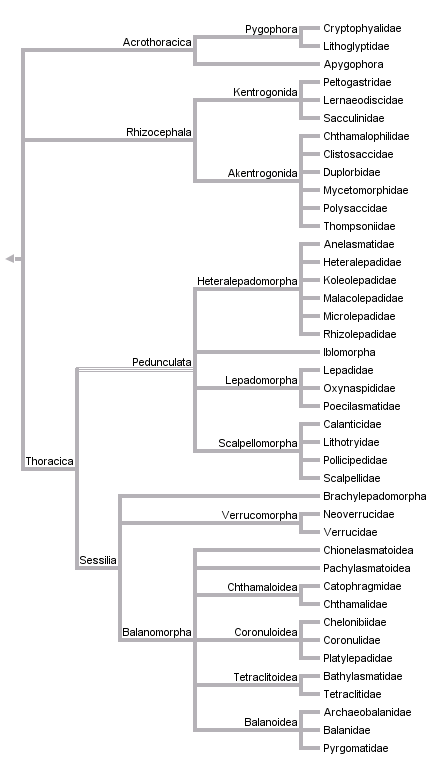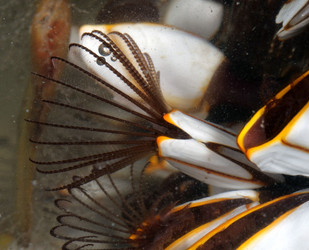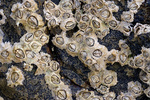Cirripedia



This tree diagram shows the relationships between several groups of organisms.
The root of the current tree connects the organisms featured in this tree to their containing group and the rest of the Tree of Life. The basal branching point in the tree represents the ancestor of the other groups in the tree. This ancestor diversified over time into several descendent subgroups, which are represented as internal nodes and terminal taxa to the right.

You can click on the root to travel down the Tree of Life all the way to the root of all Life, and you can click on the names of descendent subgroups to travel up the Tree of Life all the way to individual species.
For more information on ToL tree formatting, please see Interpreting the Tree or Classification. To learn more about phylogenetic trees, please visit our Phylogenetic Biology pages.
close boxReferences
Anderson, D. T. 1994. Barnacles. Structure, Function, Development, and Evolution. Chapman & Hall, London.
Glenner, H., M. J. Grygier, J. T. Høeg, P. G. Jensen, and F. R. Schram. 1995. Cladistic analysis of the Cirripedia Thoracica (Crustacea: Thecostraca). Zoological Journal of the Linnean Society 114: 365-404.
Harris, D. J., L. S. Maxson, L. F. Braithwaite, and K. A. Crandall. 2000. Phylogeny of the thoracican barnacles based on 18S rDNA sequences. Journal of Crustacean Biology 20:393-398.
Høeg, J. T. 1992. The phylogenetic position of the Rhizocephala: Are they truly barnacles? Acta Zoologica 73:323-326.
Høeg, J. T. 1995. The biology and life cycle of the Cirripedia Rhizocephala. Journal of the Marine Biological Association of the United Kingdom 75:517-550.
Høeg, J. T., B. Hosfeld, and P. G. Jensen. 1998. TEM studies of lattice organs of cirripede cypris larvae (Crustacea, Thecostraca, Cirripedia). Zoomorphology 118:195-205.
Høeg, J. T., M. A. Whyte, H. Glenner, and F. R. Schram. 1999. New evidence on the basic phylogeny of the Cirripedia Thoracica. Pages 101-114 in Crustaceans and the Biodiversity Crisis. Proceedings of the Fourth International Crustacean Congress, Amsterdam, the Netherlands, July 20-24, 1998, Vol. I. F. R. Schram and J. C. von Vaupel Klein, eds. Brill, Leiden.
Martin, J. W. and G. E. Davis. 2001. An updated Classification of the Recent Crustacea. Natural History Museum of Los Angeles County Science Series 39. Los Angeles, CA.
Mouchel-Viehl, E., C. Rigolot, J.-M. Gibert, and J. S. Deutsch. 1998. Molecules and the body plan; The Hox genes of cirripedes (Crustacea). Molecular Phylogenetics and Evolution 9:382-389.
Pérez-Losada, M., J. T. Høeg, G. A. Kolbasov, and K. A. Crandall. 2002. Reanalysis of the relationships among the Cirripedia and the Ascothoracida and the phylogenetic position of the Facetotecta (Maxillopoda: Thecostraca) using 18S rDNA sequences. Journal of Crustacean Biology 22:661-669.
Perl-Treves, R., L. Mizrahi, D. J. Katcoff, and Y. Achituv. 2000. E lucidation of the phylogenetic relationship of three thecostracans, Verruca, Paralepas, and Dendrogaster based on 18S rDNA sequence. Journal of Crustacean Biology 20:385-392.
Schram, F. R. and Høeg, J. T., eds. 1995. New Frontiers in Barnacle Evolution. Crustacean Issues, vol. 10. A. A. Balkema, Rotterdam.
Spears, T., L. G. Abele, and M. A. Applegate. 1994. A phylogenetic study of cirripeds and their relatives (Crustacea Thecostraca). Journal of Crustacean Biology 14:641-656.
Title Illustrations

| Scientific Name | Chthamalus stellatus |
|---|---|
| Location | near the upper shoreline, Lundy Island, UK |
| Specimen Condition | Live Specimen |
| Size | Max shell length about 10mm |
| Source | Image:Chthalamus stellatus.JPG |
| Source Collection | Wikimedia Commons |
| Image Use |
 This media file is licensed under the Creative Commons Attribution-ShareAlike License - Version 3.0. This media file is licensed under the Creative Commons Attribution-ShareAlike License - Version 3.0.
|
| Copyright | © MichaelMaggs |
| Scientific Name | Lepas anatifera |
|---|---|
| Location | North Carolina |
| Specimen Condition | Live Specimen |
| Behavior | filter-feeding |
| Source | Pelagic goosneck barnacle |
| Source Collection | Flickr |
| Image Use |
 This media file is licensed under the Creative Commons Attribution-NonCommercial-ShareAlike License - Version 2.0. This media file is licensed under the Creative Commons Attribution-NonCommercial-ShareAlike License - Version 2.0.
|
| Copyright |
© 2008 Patrick Coin

|
About This Page
Page copyright © 2009
All Rights Reserved.
- Content changed 10 December 2009
Citing this page:
Tree of Life Web Project. 2009. Cirripedia. Version 10 December 2009 (temporary). http://tolweb.org/Cirripedia/8127/2009.12.10 in The Tree of Life Web Project, http://tolweb.org/









 Go to quick links
Go to quick search
Go to navigation for this section of the ToL site
Go to detailed links for the ToL site
Go to quick links
Go to quick search
Go to navigation for this section of the ToL site
Go to detailed links for the ToL site